History and General Information of Natural Alexandrite GemStone
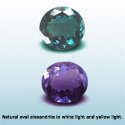 The popularity of the natural alexandrite gemstone is such that all birthstones lovers or gemologists would have seen or heard about this dramatic color-changing stone at some point in time. It is called the June Birthstone. Natural alexandrite gemstone belongs to the chrysoberyl family and display a color-change (called the alexandrite effect) which is dependent upon the source of lighting, along with strong pleochroism (an optical phenomenon by which the grains of a stone appear to be of different color when observed at different angles). While it is green or bluish-green in brilliant daylight, an alexandrite gemstone can turn a soft shade of red, purple-red or raspberry red at night in incandescent light.
The popularity of the natural alexandrite gemstone is such that all birthstones lovers or gemologists would have seen or heard about this dramatic color-changing stone at some point in time. It is called the June Birthstone. Natural alexandrite gemstone belongs to the chrysoberyl family and display a color-change (called the alexandrite effect) which is dependent upon the source of lighting, along with strong pleochroism (an optical phenomenon by which the grains of a stone appear to be of different color when observed at different angles). While it is green or bluish-green in brilliant daylight, an alexandrite gemstone can turn a soft shade of red, purple-red or raspberry red at night in incandescent light.
The ideal color change in an alexandrite gemstone (which is extremely rare and unique) would be emerald green to purple-red. This effect can work wonders on an alexandrite ring, an alexandrite earring, an alexandrite necklace or any other kind of alexandrite jewelry since the colors of this stone can be extremely mesmerizing.
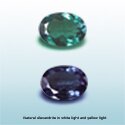 The chrysoberyl is found mainly in the yellow, brown, green and greenish yellow. These, of course, are not as popular as the other two famous chrysoberyl varieties (alexandrite and cat's eye). Although other gems like fluorite and sapphire show the color-changing phenomenon, none of them can match the color-changing quality of the natural alexandrite gems. The gem’s rarity and color changing quality have made it one of the most sought after and valued gems today. Finely faceted gems that exceed a carat are among the most expensive gemstones in the world. They are higher priced than the fine natural ruby, sapphire or natural emerald.
The chrysoberyl is found mainly in the yellow, brown, green and greenish yellow. These, of course, are not as popular as the other two famous chrysoberyl varieties (alexandrite and cat's eye). Although other gems like fluorite and sapphire show the color-changing phenomenon, none of them can match the color-changing quality of the natural alexandrite gems. The gem’s rarity and color changing quality have made it one of the most sought after and valued gems today. Finely faceted gems that exceed a carat are among the most expensive gemstones in the world. They are higher priced than the fine natural ruby, sapphire or natural emerald.
This gem was named after Czar Alexander II for two reasons. Firstly, the gem was discovered in 1830 in the Ural Mountains of Russia on the birthday of the Czar. Secondly, it’s changing colors, red and green, are the same as the Russian Imperial Guard. It has been a prevalent belief in Russia this gemstone can bring in a good omen for the owner. The stone is also believed to increase intuitive faculties of the wearer in times of a crisis.
Chemical Composition of Natural Alexandrite Gemstone
 The alexandrite's chemical formula is Beryllium Aluminum Oxide (BeO Al2 O3). The specific gravity of the regular alexandrite gem is 3.73 and the refractive index is 1.746 to 1.755. Its hardness on Mohs scale is 8.5. It has vitreous to sub adamantine polish luster.Alexandrite is a variety that belongs to the mineral group chrysoberyl.
The alexandrite's chemical formula is Beryllium Aluminum Oxide (BeO Al2 O3). The specific gravity of the regular alexandrite gem is 3.73 and the refractive index is 1.746 to 1.755. Its hardness on Mohs scale is 8.5. It has vitreous to sub adamantine polish luster.Alexandrite is a variety that belongs to the mineral group chrysoberyl.
Physical Properties of Natural Alexandrtie GemStone
Alexandrite Color
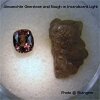 The best alexandrites exhibit a grass green color in daylight that turns to a raspberry red in yellow colored light. It is therefore, called a gem that is ‘emerald by day and ruby by night’. The color change is so drastic that it is almost like owning two different types of jewels for the current price of one. However, even though the saying is true to a certain extent the color changing sign of this gemstone, green or red, do not come close to the deep colors of the ruby gemstone or the emerald gemstone.
The best alexandrites exhibit a grass green color in daylight that turns to a raspberry red in yellow colored light. It is therefore, called a gem that is ‘emerald by day and ruby by night’. The color change is so drastic that it is almost like owning two different types of jewels for the current price of one. However, even though the saying is true to a certain extent the color changing sign of this gemstone, green or red, do not come close to the deep colors of the ruby gemstone or the emerald gemstone.
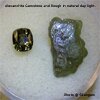 The color change in this gem takes place due to the presence of chromium. The gem simply lets the reddish or greenish light pass through it. If the gem is kept in a light that is rich in red color, the gem looks red. If it is kept in a rich green light, the gem looks green. The finest color of alexandrite is green to bluish green in daylight and red to purplish-red in yellow light.
The color change in this gem takes place due to the presence of chromium. The gem simply lets the reddish or greenish light pass through it. If the gem is kept in a light that is rich in red color, the gem looks red. If it is kept in a rich green light, the gem looks green. The finest color of alexandrite is green to bluish green in daylight and red to purplish-red in yellow light.
Cut
This gem is both rare and expensive. Therefore, it is extremely important to cut the rough gem in a planed manner with minimal wastage on the shop floor to ensure a well faceted gemstone. The gem is mostly cut in a round or oval cut, though other cuts like cushion, square princess etc are also used at times.
Carat
Natural alexandrite gemstone above 5 carats is extremely rare and can fetch an exotic price. However, a gem below 5 carats too is also not as low in price as most of the other gems in the chrysoberyl group.
Clarity
This gemstone may not be very visibly heavily included most of the times and visible inclusions are few. However if the inclusions are present, then it can reduce the perception of the gem being clean and can bring down the value of the gemstone.
Price, Cost and Buying of Natural Alexandrite Gemstone
 Genuine alexandrite gemstone is the most expensive amongst the color changing gemstones. The gem is rarely available in the Indian market. Synthetic alexandrite or lab alexandrites and natural alexandrite simulants are available in plenty in the gem market today.
Genuine alexandrite gemstone is the most expensive amongst the color changing gemstones. The gem is rarely available in the Indian market. Synthetic alexandrite or lab alexandrites and natural alexandrite simulants are available in plenty in the gem market today.
Therefore, if you come across this gem, it is very important to check the source of this gem and procure proper certification before purchase. You can rest assured in peace if the gem you are buying is certified. The main guide to pricing for the gem depends on the gems ability to change color in the light. The more conspicuous the change in color, the more valuable the gem is likely to be. Other factors that are considered are carat weight, cut and clarity.
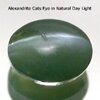 A fairly good quality average alexandrite gemstone is likely to have a sale price of anywhere between $ 500 and $5000 in the market. It is for this reason that natural alexandrite jewelry is extremely difficult to afford. Other large items are almost impossible to think of. An excellent 11.08cts from brazil was sold for $382,680 in the year 1997 in an auction by Christie’s. Alexandrite cat’s eyes are also very rare and expensive.
A fairly good quality average alexandrite gemstone is likely to have a sale price of anywhere between $ 500 and $5000 in the market. It is for this reason that natural alexandrite jewelry is extremely difficult to afford. Other large items are almost impossible to think of. An excellent 11.08cts from brazil was sold for $382,680 in the year 1997 in an auction by Christie’s. Alexandrite cat’s eyes are also very rare and expensive.
Markets and Producers of Natural Alexandrite Gemstone
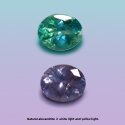 The Ural Mountains in Russia are home to the finest alexandrites, the largest cut stones being in the 30 carat range. Although Russia was the original source of this gem, today the majority of rough are being mined in Sri Lanka (up to 65cts).
The Ural Mountains in Russia are home to the finest alexandrites, the largest cut stones being in the 30 carat range. Although Russia was the original source of this gem, today the majority of rough are being mined in Sri Lanka (up to 65cts).
The gem is also mined in India (Andhra Pradesh), Burma (now Myanmar), Minas Gerais in Brazil, Madagascar and Siberia. Special Zimbabwe stones that are small and usually below 1 carat with intense color-changing qualities can also be found and considered popular. Rare and elusive alexandrite cat’s eye can also be found in India. There are no known treatments to enhance the beauty of this gemstone. It is generally sold untreated and unheated in the market.
Synthetic Alexandrites
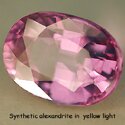
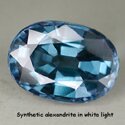 Synthetic alexandrite is made by Creative Crystals of California and the Kyocera Corporation of Japan (Inamori). Even synthetic alexandrite cat’s eye are produced and marketed by Inamori. The change in color in these synthetics is similar to the Russian quality alexandrite, where the color changes from bluish green to violet red. Lab alexandrites are less likely to be similar to the yellowish green of the Sri Lankan Stones.
Synthetic alexandrite is made by Creative Crystals of California and the Kyocera Corporation of Japan (Inamori). Even synthetic alexandrite cat’s eye are produced and marketed by Inamori. The change in color in these synthetics is similar to the Russian quality alexandrite, where the color changes from bluish green to violet red. Lab alexandrites are less likely to be similar to the yellowish green of the Sri Lankan Stones.
Simulants of Natural Alexandrite Gemstones
All natural and synthetic color-changing gems can pass off as ‘simulants’ or ‘imitation alexandrites’ (simulated alexandrites). The color-changing sapphires, spinels, garnets and synthetic alexandrites are such examples. Enstatite and Epidote, although not color changing gems, are often confused with the green color of the alexandrite. Synthetic alexandrite is also used as an active laser medium. Top quality natural alexandrite gemstones are so rare that it is hardly ever used in modern jewelry. With a little luck, one can find fine alexandrites in antique natural Russian jewelry, since master jewelers in Russia loved this stone.
Interesting Trivia about Alexandrite Gemstone
 Tiffany’s master gemologist George Frederick Kunz (1856-1932) was so fascinated by this gem that the firm produced some beautiful series of rings and platinum ensembles to showcase the amazing gem at the end of the 19th and beginning of the 20th century.
Tiffany’s master gemologist George Frederick Kunz (1856-1932) was so fascinated by this gem that the firm produced some beautiful series of rings and platinum ensembles to showcase the amazing gem at the end of the 19th and beginning of the 20th century.
Many times Lab created alexandrite (synthetic) which are actually corundum laced with trace elements or color changing spinel gemstone (not chrysoberyl), are sold as synthetic alexandrites.
It is these synthetics that are commonly found in jewelry to since genuine alexandrite rings will obviously prove to be too expensive for the common man. Other pieces of jewelry this stone is commonly used in are alexandrite earrings.
The Natural alexandrite gemstone is the birthstone for people born in the month of June. Hence this stone is also called as June Birthstone.
Home | Add URL | About Us | Contact Us | Links | Privacy Policy | Resources | Sitemap | Design by Paper Tree
Copyright 2007 GehnaBazaar.com. All rights reserved. The information contained in this webpage may not be published, broadcast, rewritten or redistributed without a prior written consent. Natural Gemstones | Precious Gemstones | Jewellery Designers | Jewelry Institutes | Jewelery Design Institutes | Gemstone Information | Diamond Information | Gemmological Laboratories | Gem Labs | Jewelry Articles | Gold Price | Jewel Store | Buy and Sell Jewellery | Jewery Classes | Deisgn classes | Gemologists | Diamond Price